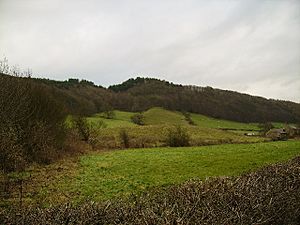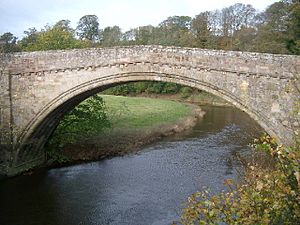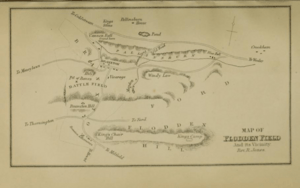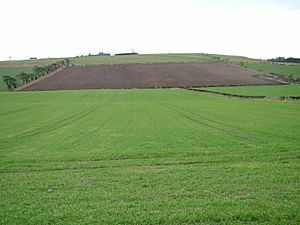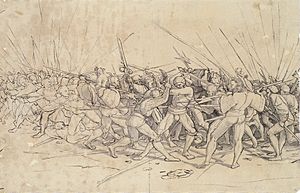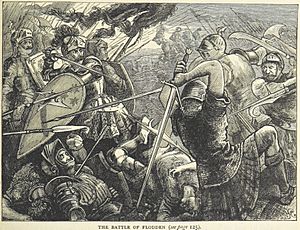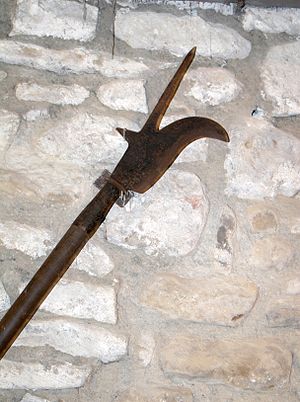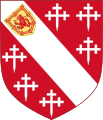Battle of Flodden facts for kids
Quick facts for kids Battle of Flodden |
|||||||
|---|---|---|---|---|---|---|---|
| Part of the War of the League of Cambrai | |||||||
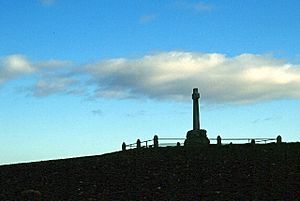 The Flodden Memorial on Piper's Hill, overlooking the site of the battle |
|||||||
|
|||||||
| Belligerents | |||||||
| Commanders and leaders | |||||||
Earl of Lennox † |
|||||||
| Strength | |||||||
| 26,000 | 30,000 – 40,000 | ||||||
| Casualties and losses | |||||||
| 1,500 killed | 5,000 – 14,000 killed | ||||||
The Battle of Flodden was a major battle fought on September 9, 1513. It took place near Branxton in northern England. This battle was between the armies of England and Scotland. It was one of the largest battles ever fought between these two kingdoms.
The Scottish army was led by King James IV. The English army was commanded by the Earl of Surrey. The battle ended with a victory for England. King James IV was killed during the fighting. He was the last king from the British Isles to die in battle. Many Scottish nobles also died, causing a big crisis in Scotland.
Contents
Why the Battle Happened
For many years, England and Scotland had fought off and on. In 1502, they signed a peace treaty called the Treaty of Perpetual Peace. But this peace did not last long. There were arguments over raids across the border. Also, Scottish ships were captured, and a Scottish privateer (a legal pirate) named Andrew Barton was killed.
King Henry VIII of England also claimed to be the ruler of Scotland. This made things worse. So, King James IV decided to declare war on England. He did this to help his ally, France. England was fighting France at the time. James wanted to make Henry VIII bring his troops back from France.
Pope's Warning to James IV
The Pope, Pope Leo X, was on England's side. He warned James IV not to break his peace treaties with England. On June 28, 1513, the Pope sent a letter threatening James. Later, James was even excommunicated (kicked out of the church) by a cardinal.
James also sent his navy to help France. But the Scottish fleet was delayed and did not join the war. This was bad because James had sent many of his skilled artillerymen (cannon experts) with the navy. This left his land army with less experienced gunners.
Henry VIII's Response
King Henry VIII was in France, fighting the French. James IV sent a message asking him to stop attacking France. Henry VIII was very angry. He told James's messenger that James had no right to tell him what to do. Henry said James should be his ally, especially since James was married to Henry's sister, Margaret.
Henry warned James that if he invaded England, he would regret it. He also said he cared about his sister being treated badly. Henry then wrote a letter on August 12, saying he would fight back against any invasion.
Scottish Invasion of England
James IV invaded England with about 30,000 men. He used the excuse of getting revenge for the murder of Robert Kerr, a Scottish border warden. But both sides had been getting ready for war for a long time. Henry VIII had already prepared an army in northern England.
The Earl of Surrey was put in charge of the English army in the north. He started gathering more troops from northern England.
The "Ill Raid"
Before the main invasion, a group of about 7,000 Scottish border fighters, led by Lord Home, crossed into Northumberland. They raided farms and villages, taking goods and burning houses.
The English had sent Sir William Bulmer with archers to stop them. On August 13, the English ambushed the Scots as they returned home. The English archers surprised the Scots, killing many of them. The Scots had to leave their stolen goods behind. This "Ill Raid" showed James that fighting in open fields against the English archers could be dangerous.
The Invasion Continues
On August 18, Scottish cannons were moved from Edinburgh Castle to start the invasion. King James IV himself left on August 19. He had two new flags for St Margaret and St Andrew.
Catherine of Aragon, Henry VIII's wife, was in charge of England while he was away. When she heard about the invasion, she ordered more armies to be raised.
The Scottish army, with about 42,000 men, crossed the River Tweed into England around August 22. Scottish soldiers were not paid much. They only had to serve for forty days.

After crossing the border, part of the army attacked Wark on Tweed Castle. The main army went downstream to attack other border castles. On August 29, after a six-day siege, Norham Castle was captured and partly destroyed by Scottish cannons. The Scots then moved south, taking Etal and Ford.

Some stories say that King James wasted time at Ford Castle with Lady Heron. But other accounts say she was a prisoner. She might have negotiated her release and saved Ford Castle from being destroyed.
Meanwhile, the Earl of Surrey was gathering his English army. He arrived at Durham Cathedral on August 28. There, he was given the banner of Saint Cuthbert. This banner had been carried by the English in past victories against the Scots.
Surrey's Challenge to James
On September 4, James and the Scottish army took a strong position on Flodden Edge. This was a hill with marshes on one side and steep slopes on the other. This made it very hard to attack directly. It is not clear how much James built defenses on the hill. Recent digs found no signs of 16th-century walls.
The Earl of Surrey sent a challenge to James IV. He said James had agreed to fight on the plain at Milfield. Surrey complained that James was hiding on the hill like in a fortress. James replied that it was "not fitting for an Earl to seek to command a King." He refused to leave his strong position.
Surrey was in a difficult spot. Attacking uphill would likely mean defeat. But refusing to fight would bring shame. His army also needed food and supplies. So, Surrey came up with a clever plan. He would try to outflank the Scots.
The Battle Begins
English Maneuvers
On September 8, Surrey moved his army east across the River Till. He then headed north, camping near Lowick. James might have thought Surrey was going to Berwick-upon-Tweed for supplies. But Surrey planned to get behind the Scottish army.
Early on September 9, Surrey's men moved west towards Branxton Hill. This hill was less than two miles north of James's camp. To cross the River Till again, the English army split. One part, led by Surrey, crossed at several shallow spots. A larger group, with the cannons, crossed at Twizell Bridge.
James quickly saw the English plan. He ordered his army to leave their camp and move to Branxton Hill. This new position would still give his soldiers the advantage of attacking downhill. However, the Scots were moving onto ground they did not know well.
The English commander, Lord Admiral Thomas Howard, reached Branxton village. He did not know about the new Scottish position because smoke from burning rubbish hid it. When he finally saw the Scots on Branxton Hill, he sent a message to his father, Surrey, to hurry. James chose not to attack the English while they were crossing the river. He wanted to fight them all on one open field.
Armies and Weapons
James's army had about 34,000 men. This was more than the English army, which had about 26,000. The Scottish army was divided into four main groups. The Scottish foot soldiers had long pikes (spears) about 18 feet long. These were new weapons from France. They were powerful but needed good training and flat ground to work well.
The Scottish cannons were heavy siege guns. They could fire a large iron ball far away. But they were very slow to move and fire. Each heavy cannon needed 36 oxen to pull it. They could only fire once every twenty minutes. The king's secretary, who had no experience with cannons, commanded them.
Surrey placed his troops on Piper Hill, facing the Scots. The English foot soldiers used traditional pole weapons, mostly bills. Bills were like long axes with hooks. The English also had many skilled archers with longbows. The English cannons were lighter and older. But they were easy to move and could fire quickly.
The Fight Begins
Around 4 pm on Friday, in wet and windy weather, the battle started with cannons firing. The Scottish cannons did not work well. They were hard to aim downhill and had been set up too quickly. This made them fire slowly. The English cannons, however, fired quickly at the Scottish soldiers.
Next, the Scottish left wing, led by Home and Huntley, moved downhill. They advanced "in good order" without speaking. The English archers could not hurt the heavily armored Scottish front line much. The English were pushed back. But Surrey sent in his light horsemen, who attacked the Scots from the side. This part of the battle ended in a standstill. Both sides stopped fighting and did not join the main battle again.
King James then ordered the next Scottish group to advance. As they moved down Branxton Hill, they hit a hidden problem: a marshy area. Days of heavy rain had made the ground very wet. As the Scots struggled through the mud, their pike formations broke apart. The long pikes became useless. The Scots dropped them and pulled out their swords and axes. But the English bills were longer, giving them an advantage in the close fighting.
King James himself led his men down the hill. He was known for taking risks in battle. His men also struggled in the marshy ground. But they fought their way close to Surrey's personal guards. The last Scottish group, the Highlanders, held back.
The last English group, led by Stanley, finally arrived on the right side of the Scottish line. They fired many arrows into the Highlanders, who had little armor. The Highlanders suffered heavy losses and ran away.
The fierce fighting continued, especially around King James. As other English groups won their fights, they moved to help Surrey. The English had been told not to take prisoners. This explains why so many Scottish nobles died.
King James IV was killed at the end of the battle. His body was found surrounded by his special guards, the "Flowers of the Forest." Even with his best armor, the king had two arrow wounds and cuts from other weapons. He was the last king in the British Isles to die in battle. Only Home, Huntley, and their troops escaped the battle in good order. Other Scots escaped in small groups, chased by the English.
What Happened After the Battle
Soon after the battle, Scotland asked Denmark for help. They said James IV had made a mistake by attacking downhill on marshy ground. They also said Scottish officers fought in the front lines, making them easy targets. English generals stayed behind, safer. This meant Scotland lost many leaders, making it hard to organize a retreat.
Weapons Used
Flodden was a victory for the English bill over the Scottish pike. Pikes were good for moving battles and stopping cavalry. But the hilly, wet ground at Flodden made them hard to use. The English bills were better for close-up fighting. One English report said, "the English halberdiers decided the whole affair."
This battle was one of the first in Britain where cannons were used a lot. Scottish cannons fired over the English heads. But the English cannons were more effective.
English archers also played a big part. Many archers came from Lancashire and Cheshire. Sir Richard Assheton led a company from Middleton. His church, St. Leonard's, Middleton, has a special "Flodden Window." It shows the archers and is thought to be the oldest war memorial in the UK.
Rewards and Honors
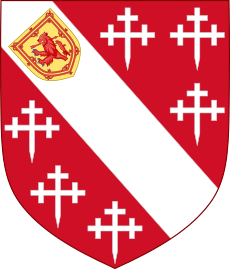
As a reward for his victory, Thomas Howard was given back his family title of Duke of Norfolk. The Norfolk family's coat of arms still has a special addition to remember Flodden. It shows a modified Scottish lion with an arrow through its mouth.
Some items believed to belong to James IV were taken by the English. These included his banner, sword, and thigh armor. They were taken to Durham Cathedral.
Legends of King James IV
Lord Dacre found the body of James IV on the battlefield. He later wrote that the Scots hated him for finding their king's body. The body was taken to Berwick-upon-Tweed and then to Newcastle upon Tyne. It was later brought to Sheen Priory near London.
Catherine of Aragon sent news of the victory to Henry VIII. She sent him James's blood-stained coat and iron gloves. She suggested Henry use the coat as his battle flag.
Soon after the battle, stories spread that James IV had survived. Some said he was seen in Kelso after the battle. Others said he went on a secret trip to faraway lands.
There was also a legend that James had been warned not to invade England by a strange man in blue. This man appeared while James was praying and then vanished. Other strange signs were also reported, like a hare running from his tent and mice gnawing his helmet.
Scotland After Flodden
James IV's wife, Margaret Tudor, waited for news of her husband at Linlithgow Palace. Ten days after the battle, Scottish leaders met. They set up a council to rule Scotland. This council would rule for Margaret Tudor and her young son, James V of Scotland.
The Scottish Parliament met on October 21. The 17-month-old King James V was crowned. Special rules were made for the families of those killed at Flodden. Margaret Tudor became the guardian of the King.
A French soldier arrived in Scotland with weapons. He pushed for John Stewart, Duke of Albany, a relative of the king, to become Regent (ruler) of Scotland. Albany arrived in Scotland in May 1515. By then, Margaret had given birth to James's last son and married the Earl of Angus.
How Many Died
Surrey's English army lost about 1,500 men. The number of Scottish dead varies in different reports. Some said 10,000, others 12,000, or even 18,000. George Buchanan, a historian, wrote that about 5,000 Scots were killed.
Almost every noble family in Scotland lost a member at Flodden. The sad losses are remembered in the famous Scottish song "Flowers of the Forest":
- We'll hae nae mair lilting, at the yowe-milking,
- Women and bairns are dowie and wae.
- Sighing and moaning, on ilka green loaning,
- The flowers of the forest are all wede away.
English songs also remembered the many Scottish deaths:
- To tell you plaine, twelve thousand were slaine,
- that to the fight did stand;
- And many prisoners tooke that day,
- the best in all Scotland.
- That day made many a fatherlesse childe,
- and many a widow poore;
- And many a Scottish gay Lady,
- sate weeping in her bowre.
A legend says that a demon called Plotcock read out the names of those who would die at the Mercat Cross in Edinburgh. One man, Richard Lawson, threw a coin to protest this and survived the battle.
Some of the dead from the battle were buried at Branxton Church. Many Scottish nobles are thought to have been buried at Kirk Yetholm, the closest holy ground in Scotland.
Important Scots Who Died
- Alexander Stewart, Archbishop of St. Andrews (King James IV's son)
- George Hepburn, Bishop of the Isles
- William Bunche, Abbot of Kilwinning
- Laurence Oliphant, Abbot of Inchaffray
- Sir William Knollys, Lord St. John
- Archibald Campbell, 2nd Earl of Argyll
- Adam Hepburn, 2nd Earl of Bothwell
- David Kennedy, 1st Earl of Cassilis
- William Sinclair, 2nd Earl of Caithness
- John Lindsay, 6th Earl of Crawford
- William Hay, 4th Earl of Erroll
- Matthew Stewart, 2nd Earl of Lennox
- John Douglas, 2nd Earl of Morton
- William Graham, 1st Earl of Montrose
- William Leslie, 3rd Earl of Rothes
- Andrew Stewart, 1st Lord Avondale
- William Borthwick, 3rd Lord Borthwick
- Alexander Elphinstone, 1st Lord Elphinstone
- Thomas Stewart, 2nd Lord Innermeath
- John Maxwell, 4th Lord Maxwell
- John Ross, 2nd Lord Ross
- George Seton, 5th Lord Seton
- John Sempill, 1st Lord Sempill
- Robert Erskine, 4th Lord Erskine
- Robert Arnot of Woodmill, Comptroller of Scotland
- Sir Duncan Campbell of Glenorchy
- Sir Iain (John) MacFarlane, Chief of Clan MacFarlane
- Sir William Cockburn of Langton and his eldest son
- Sir Robert Crawford of Kilbirnie
- William Cunningham, 1st Laird of Craigends
- George Douglas, Master of Angus
- Sir William Douglas 6th of Drumlanrig
- Sir William Douglas of Glenbervie
- Robert Elliot, Chief of Clan Elliot
- Archibald Graham, 3rd of Garvock (King James' cousin)
- George Graham, 1st of Calendar
- Alexander Guthrie of Kincaldrum, and his son David
- James Henderson of Fordell, Lord Justice Clerk
- Adam Hepburn of Craggis
- William Hoppringill 1st laird of Torwoodlee
- Sir Alexander Lauder of Blyth, Provost of Edinburgh
- David, William, and George Lyon (brothers-in-law of Alexander Guthrie)
- Lachlan MacLean, Chief of Clan Maclean
- Thomas Maule of Panmure
- John Muirhead, Laird of Muirhead
- Archibald Napier of Edinbellie
- Colin Oliphant, Master of Oliphant
- Alexander Ramsay of Dalhousie
- Sir John Ramsay of Trarinzeane
- Sir William Seton
- Sir John Somerville of Cambusnethan
- John Hunter 14th Laird of Hunterston
- William Wallace 11th of Craigie
English Soldiers Knighted at Flodden
About 45 English soldiers were made knights by the Earl of Surrey after the battle.
- Lord Scrope of Upsall
- Edmund Howard
- George Darcy
- William Gascoigne, junior
- William Middleton
- William Mauleverer, of Arncliffe
- Thomas Berkeley
- Marmaduke Constable, junior
- Christopher Dacre
- John Howthom
- Nicholas Appleyard
- Edward Gorge
- Ralph Ellerker, junior
- John Willoughby
- Edward Etchingham
- William Pennington
- John Stanley
- Walter Stonor
- Ninian Markenfield of Markington
- Thomas Burgh
- Ralph Bowes
- William Roos
- Bryan Stapleton of Wyghall
- William Newton
- Thomas Newton
- Guy Dawnay
- Roger Grey
- Ralph Salvayne
- Roger Collingwood
- Richard Mauleverer
- William Mauleverer
- Roger Farewell
- William Constable of Hatfield
- William Constable of Carthorpe
- Thomas Stranguishe
- John Bulmer
- Christopher Danby, of Thorp Perrow
- Edmund Walsingham
- Thomas Conyers
- Roger Fenwick, Constable of Newcastle
- Edward Musgrave, of Hartley
- William Percy
- Christopher Pickering of Killington
- Henry Thwaites
- John Lumley
- Roger Ogle
The Battlefield Today
The battlefield still looks much like it did during the battle. But the marshy area that troubled the Scots is now drained. A monument, built in 1910, is easy to find from Branxton village. There is a small car park and a clear trail with signs that help you imagine the battle. Only the arch of the old church where James IV's body rested remains. The rest of the church was rebuilt in 1849.
Every year, the nearby Scottish town of Coldstream remembers the battle. They have a traditional horse-ride to the battlefield and a service for those who died.
Remembering the Battle
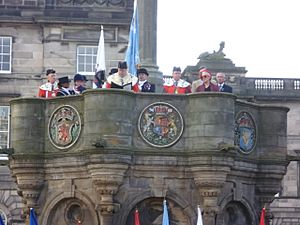
The stained-glass Flodden Window in Middleton Parish Church is thought to be the oldest war memorial in Great Britain. Sir Richard Assheton built it to remember the archers from Middleton who fought in the battle.
In 2013, the 500th anniversary of the battle was celebrated. Many projects and events brought together communities from both sides of the border. These included expanding the Flodden 1513 Ecomuseum and doing archaeology, research, and education projects.
In Stories and Films
- "Marmion: A Tale of Flodden Field" (1808) is a long poem by Sir Walter Scott about the battle.
- The novel Flodden Field by Elisabeth McNeill (2007) tells the story from different viewpoints.
- Tom Fleck by Harry Nicholson (2011) is a novel about the battle from a Yorkshire archer's view.
- The Flowers of the Forest by Elizabeth Byrd is a historical novel about Queen Margaret Tudor that ends with the Battle of Flodden.
- Arthur Sullivan wrote music called Overture Marmion (1867), inspired by Scott's poem.
- "Sunset at Noon" by Jane Oliver (1955) is a fictional story about James IV's life.
On TV
- The British TV show Two Men in a Trench showed the battle in its first season. It explained the fighting and weapons used.
- The TV series The Spanish Princess (Starz) showed the battle in its second season. It was fictionalized, for example, by showing Catherine of Aragon on the battlefield while pregnant.
Images for kids
-
Norham Castle, which fell to the Scots on 29 August after a six-day bombardment by James's artillery.
-
James IV captured Ford Castle from Lady Heron
-
The western side of the battlefield, looking south-south-east from the monument erected in 1910. towards Branxton Hill on the skyline. The Scottish army advanced down the ploughed field, the English down the grassy field in the foreground. The modern boundary between the two fields marks the position of the marsh encountered by the Scots.
-
An early 16th century depiction of pikemen in close combat with halbediers; the fighting at Flodden must have had a similar appearance.
-
Thomas Howard, 2nd Duke of Norfolk was given an augmentation of honour to commemorate the Battle of Flodden
-
On the 500th anniversary of the battle a minute's silence for the town's dead was observed at the Mercat Cross in Edinburgh
See also
 In Spanish: Batalla de Flodden Field para niños
In Spanish: Batalla de Flodden Field para niños



